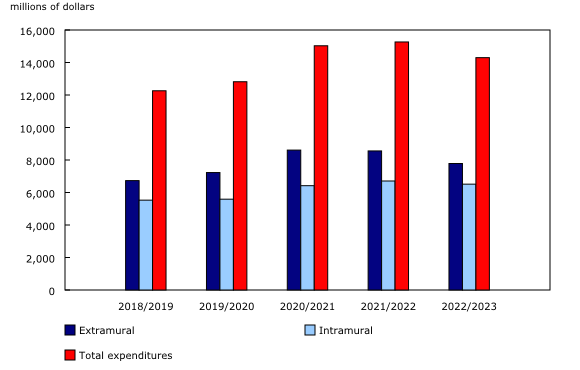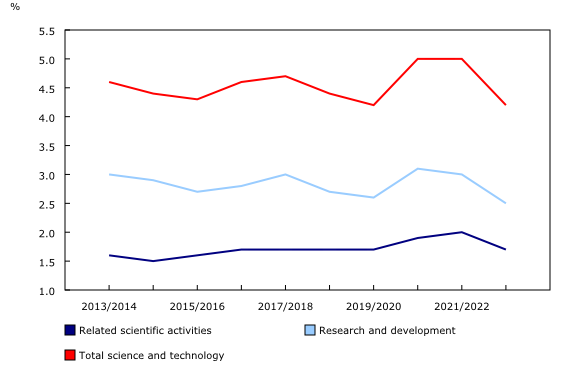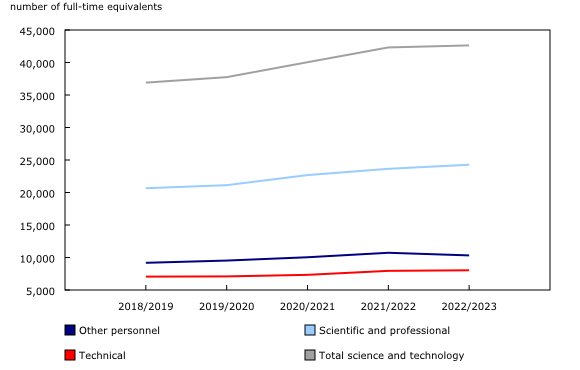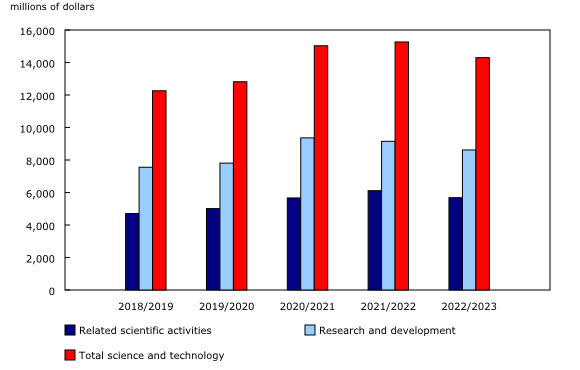Federal government spending on science and technology, 2020/2021 (actual), 2021/2022 (preliminary), and 2022/2023 (intentions)
Archived Content
Information identified as archived is provided for reference, research or recordkeeping purposes. It is not subject to the Government of Canada Web Standards and has not been altered or updated since it was archived. Please "contact us" to request a format other than those available.
Released: 2022-06-06
$14.3 billion
2022/2023
-6.3% 
(annual change)
Economic prosperity and competitiveness can be linked to a country's ability to finance and benefit from novel research, experimental development and innovation. Governments can be important agents in this regard. In 2020, the federal government increased spending related to scientific and technological activities, which was reported in the Federal Budget 2019, as a means to support businesses and research institutions and to ultimately benefit the Canadian population.
This funding occurred against the backdrop of the global COVID-19 pandemic, first impacting Canada in 2020 and constituting an unprecedented crisis with implications for all sectors of the economy. Accordingly, public and private research institutions realigned to develop, test and produce treatments, and eventually vaccination guidelines through research and development (R&D).
Spending intentions in 2022/2023 expected to drop but remain above pre-pandemic levels
Science and technology spending intentions by the Canadian federal government are expected to decrease 6.3% to $14.3 billion in 2022/2023 following seven consecutive periods of increase. While federal science and technology spending intentions are anticipated to decrease, they are likely to exceed the highest level of pre-pandemic science and technology spending, which was realized in 2019/2020 ($12.8 billion).
Federal science and technology intensity (the ratio of science and technology spending to the total of all federal government spending, measured as main estimates) is expected to return to pre-pandemic levels in 2022/2023 after reaching its highest levels in a decade during the first two years of the pandemic.
Preliminary science and technology spending and personnel both expected to grow in 2021/2022
Early estimates of science and technology spending by the Canadian federal government are expected to increase to $15.3 billion in 2021/2022 (+1.6% from the previous reference period). During this period, intramural expenditures (scientific activities carried out by in-house personnel) are expected to reach 43.9% of the total science and technology expenditures, a 4.5% increase from 2020/2021. Moreover, preliminary in-house estimates suggest similar growth in the federal science and technology workforce, increasing 5.7% to 42,318 full-time equivalents (FTEs) over this same period.
Science and technology expenditures and personnel reached record heights in 2020/2021
Actual science and technology expenditures reached new heights in 2020/2021, rising 17.3% to $15.0 billion on the strength of increased expenditures related to both extramural and intramural spending. Extramural spending, which involves contracting out science and technology work to external parties, led the charge, rising 19.1% to $8.6 billion, while intramural or in-house spending rose 14.9% to $6.4 billion.
The record spending in 2020/2021 was tied to both types of science and technology activities. R&D, which accounted for more than three-fifths (62.3%) of total science and technology spending, increased 19.9% to $9.4 billion, while related scientific activities spending was up 13.1% to $5.7 billion compared with 2019/2020.
Rise in science and technology expenditures and personnel tied to a number of public institutions
The rise in overall science and technology spending in 2020/2021 was driven primarily by the National Research Council of Canada (+41.1% to $1.7 billion), followed by the Social Sciences and Humanities Research Council of Canada (+50.8% to $1.4 billion) and Health Canada (+113.8% to $836 million). The growth in overall spending was expected based on spending commitments from the Federal Budget 2019, which focused on building research excellence in Canada.
The National Research Council of Canada's science and technology expenditures rose as a result of increased financial support to businesses through various initiatives, such as the Industrial Research Assistance Program as well as R&D activities related to COVID-19.
Social Sciences and Humanities Research Council of Canada's expenditures increased as a result of various collaborative initiatives with federal research funding agencies and other stakeholders.
Health Canada's increase in expenditures was predominately tied to intramural science and technology activities, with most of the expenditures concentrated on related scientific activities (89.5%). These types of activities are generally associated with information gathering on the part of R&D projects, as well as analysing and disseminating information, and providing education supports to institutions.
Employee-wise, these three institutions saw strong growth in the number of FTEs, with Health Canada leading the way as its science and technology personnel more than doubled (+3,237 FTEs) to 6,303 FTEs. The National Research Council of Canada followed with a gain of 152 FTEs to 4,261 FTEs, while the Social Sciences and Humanities Research Council of Canada rose by 35 FTEs to 310 FTEs.
Extramural spending rose across all performing sectors
The increases in extramural science and technology expenditures were widespread across all performing sectors. The largest gains were recorded by higher education institutions (+$840 million to $4.7 billion), foreign performers (+$191 million to $929 million), and business enterprises (+$178 million to $1.8 billion).
Federal expenditures by geography
The gains in science and technology expenditures were led by Ontario (+$852 million to $3.6 billion), followed by the National Capital Region (+$544 million to $4.0 billion), Alberta (+$357 million to $976 million) and Quebec (+$305 million to $2.1 billion). The increase in science and technology spending in Alberta marks a turn-around following two years of declines, and was brought on by increased R&D spending in the natural sciences performed by higher education institutions.
By contrast, a small number of provinces saw their science and technology expenditures fall in 2021. The largest decrease was observed in British Columbia where spending fell by $271 million to $1.3 billion due to decreased payments to higher education institutions for R&D in the natural sciences.
Note to readers
Federal Science Expenditures and Personnel, Activities in the Social Sciences and Natural Sciences is an annual survey of all federal government departments and agencies that perform or fund science and technology activities. Actual data for 2020/2021, preliminary data for 2021/2022 and intentions for 2022/2023 were collected from September to December 2021, based on the federal government's fiscal year running from April 1 to March 31.
Science and technology activities comprise two types of scientific activities: research and development (R&D), and related scientific activities (RSA). They can be defined as all systematic activities that are directly related to the generation, advancement, dissemination and application of scientific and technical knowledge in all fields of science and technology.
Research and development comprise creative and systematic work done to increase the stock of knowledge—including knowledge of humankind, culture and society—and to devise new applications of available knowledge. R&D activities must satisfy all five of the following core criteria:
1. They are aimed at new findings (novel).
2. They are based on original, not obvious, concepts and hypotheses (creative).
3. They are uncertain about the final outcome (uncertainty).
4. They are planned and budgeted (systematic).
5. They lead to results that could be possibly reproduced (transferable/or reproducible).
Related scientific activities are all systematic activities directly related to the generation, advancement, dissemination and application of scientific and technological knowledge. RSA generally include general purpose data collection, which excludes the collection of data as part of an R&D project; information services (the collection, coding, analysis, evaluation, recording, classification, translation and dissemination of scientific and technological information); special surveys and studies (systematic investigations carried out to provide information needed for planning or policy formulation); education supports (grants to support the postsecondary education of students in the natural or social sciences and technology).
Natural sciences and engineering consist of all disciplines concerned with understanding, exploring, developing or using the natural world. Included are engineering, technology, mathematics, computer and information sciences, physical sciences, medical and health sciences, agricultural sciences, veterinary sciences, and forestry.
Social sciences, humanities and the arts consist of disciplines concerned with the study of human actions and conditions and the social, economic and institutional mechanisms that affect humans. Included are the arts, economics and business, education, history and archeology, law, languages and linguistics, media and communications, philosophy, ethics and religion, psychology and cognitive sciences, social and economic geography, and sociology.
The performer is equivalent to the sector in which the scientific activity is conducted. The basic distinction is between intramural and extramural performance.
Intramural (in-house) activities include all current expenditures incurred for scientific activities carried out by in-house personnel of units assigned to the program.
Extramural (outsourced) activities include all expenditures incurred by the federal government's agencies and departments for scientific activities carried out by the five following performers: business enterprises, higher education, Canadian non-profit institutions, provincial and municipal governments and foreign performers.
Full-time equivalent is the personnel expressed as a ratio of working hours actually spent on scientific activities during a specific reference period divided by the total number of hours conventionally worked in the same period by an individual or a group. For example, an employee who is engaged in scientific activities for half a year has a full-time equivalence of 0.5.
Scientific and professional personnel (also called researchers) are professionals engaged in the conception or creation of new knowledge. They conduct research and improve or develop concepts, models and methods. Managers and administrators who plan and manage the scientific and technical aspects of a researcher's work, as well as graduate students, are also included.
Technical personnel perform scientific and technical tasks involving the application of concepts and operational methods in one or more fields of the natural sciences and engineering, or of the social sciences, humanities and the arts, normally under the supervision of researchers.
Other personnel (also called support staff) includes skilled and unskilled workers, as well as administrative, secretarial and clerical staff directly associated with research and development projects.
More information on the concepts and definitions of the survey (4212) is available from this release's Related information tab.
To better understand the concepts outlined in this survey, please consult the Frascati Manual 2015: Guidelines for Collecting and Reporting Data on Research and Experimental Development.
Contact information
For more information, or to enquire about the concepts, methods or data quality of this release, contact us (toll-free 1-800-263-1136; 514-283-8300; infostats@statcan.gc.ca) or Media Relations (statcan.mediahotline-ligneinfomedias.statcan@statcan.gc.ca).
- Date modified:






